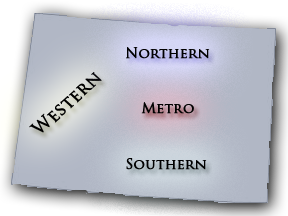To audition for Colorado All-State Choir, students must be a junior or senior and must be currently enrolled in their high school vocal music program. (Note: home schooled students are required to be enrolled in their local high school’s vocal music program to audition.) Auditions are held each fall to place students in one of three choirs to perform in the spring. Auditions are scored on a point system using a variety of qualified judges from the Colorado region. Raw scores are then configured into “Z-Score” to account for different judges and voice parts. Directors are encouraged to use the Director’s Checklist Document to ensure all details are taken care of.
Boundary Assignments

![]() Boundary Assignments for Audition Sites by County
Boundary Assignments for Audition Sites by County
NOTE: Directors may petition to audition at an alternate site. Complete the Petition Form for each student and follow directions on the form.
Audition Site Locations & Dates
![]() Fall 2025 Audition Sites/Dates + Site Contacts
Fall 2025 Audition Sites/Dates + Site Contacts
Please note that as of Fall 2024 – auditioning students must present their Photo ID at check-in.
Procedures & Requirements
Directors should read and review the following document to fully understand audition procedures and requirements.
![]() Director’s Responsibility Form – Fall 2025
Director’s Responsibility Form – Fall 2025
![]() Procedures and Requirements – Revised Fall 2025
Procedures and Requirements – Revised Fall 2025
![]() IEP/504 Accommodation Request Form – Fall 2025
IEP/504 Accommodation Request Form – Fall 2025
Audition Ranges
Directors should use the following ranges as a guide when selecting what voice part works best for their student(s).
Audition Order & Scoring Card
The audition consists of the following:
PREPARED SOLO: 50 Points
Original score for judge required. Jazz, Pop, and Musical Theatre songs are NOT permitted.
Tone Quality – 10
tone, breath support, vowels, appropriate style
Intonation – 10
singing in tune
Accuracy – 10
accuracy of notes and rhythms
Diction – 10
text clarity, accurate pronunciation
Musicality – 10
dynamics, sensitivity to text, articulation to convey appropriate meaning
SENSE OF TONALITY: 10 Points
Any method is suitable: Solfege, numbers, ‘la’, etc..
Note: Scales will be performed before Triads starting Fall 2017.
Major Scale – 2
Harmonic Minor Scale – 2
Melodic Minor Scale – 2
Major Triad – 1
Minor Triad – 1
Diminished Triad – 1
Augmented Triad – 1
INTERVALS: 8 Points
Any sung/hummed note will be scored – Do NOT hum or sing to “practice.”
Sing requested interval from given pitch – 4 (2 intervals, 2 pts ea.)
Identify interval between two pitches – 4 (2 intervals, 2 pts ea.)
TONAL RECALL: 8 Points
A short melodic example will be played twice on the piano with a slight break between playings.
Sing the example a cappella on a neutral open syllable such as “na na,” “la la,” or “da da.” 8 (2 examples, 4 pts ea.)
SIGHT READING: 24 Points
Any method may be used: Solfege, numbers, ‘la’, etc..
Melodic Sight Reading – 16 (2 examples, 8 pts ea.)
Rhythmic Sight Reading – 8 (1 example, 8 pts)
Scoring occurs from what students say.
Any method may be used: Beat Numbers, ‘ta’, ‘da’, etc..
Each student will receive a RAW SCORE out of 100 possible points. That score will then be calculated into a “Z-Score” to account for the different judges, their averages, and the amount of students that are needed for each choir. The “Z-Score” cut off is different for each voice part, and will change every year.
![]() Sample Audition Card (Updated Fall 2024)
Sample Audition Card (Updated Fall 2024)
Sample Audition Videos
The videos below provide examples of a student going through the audition process. Please note that these videos are in the process of being updated. The following changes are NOT represented in our Sample Audition Videos:
- Solos will now be limited to 2 minutes and 30 seconds. The judge will most likely stop your audition after the 2 minute, 30 second mark.
Scoring will not be impacted if the judge stops your solo. Here are some suggestions to shorten your solo time if needed:- Clearly mark your original score with any cuts for your judge.
- We are encouraging singers to eliminate multiple verses. Please do not sing more than 2 if your piece is strophic.
- Eliminate any excessive piano introductions, interludes, or extended cadential passages.
- There have been changes to the audition and scoring (See above for updated information regarding Tonal Recall).
Z-Score
Colorado All State Choir runs audition tabulation based on a function called Z Score. First, all students from a particular judge are listed and compared with the average and standard deviation of that judge. The standard deviation shows the score spread for each judge. The judge’s average score less the student’s Raw Score is divided by the judge’s standard deviation. The result will be a number roughly between -2 and +2. This number is the student’s “Z Score.” The average scoring student from that judge will receive a “z score” near zero. The Z-score allows for the best mathematical method to account for the varying difficulty of a judge’s scoring. As a result, a student’s raw score from one judge can produce a seemingly different z score than expected. The score cut offs for the choirs are made by “z score.”
The formula is:
(Student Raw Score – Judge’s Average Score) / Standard Deviation of Judge = Z Score
Example: ( 78 – 73 ) / 12.5 = .40000

